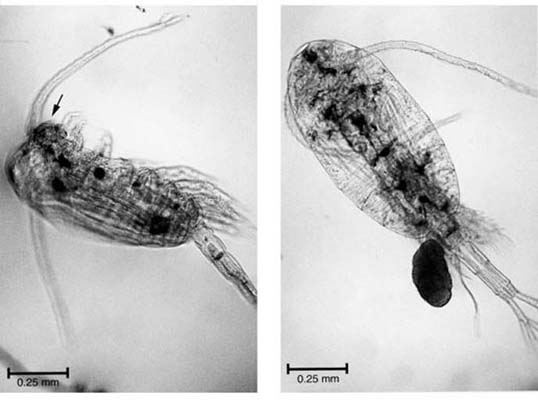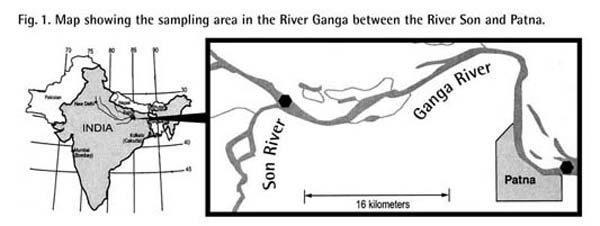Biological and Chemical Characteristics of the River Ganga (Ganges)
Skip other details (including permanent urls, DOI, citation information): This work is protected by copyright and may be linked to without seeking permission. Permission must be received for subsequent distribution in print or electronically. Please contact [email protected] for more information.
For more information, read Michigan Publishing's access and usage policy.
The River Ganga, a lifeline for millions, drains one of the world's largest and most densely and continuously occupied watersheds. It is critical to the health, prosperity, and spirituality of the millions living on the Northern Alluvial Plains of India. The river is used for drinking, power generation, irrigation, fish production, and religious pilgrimages. It has been under constant threat of pollution by sewage and industrial waste, disposal of dead bodies, deforestation, excessive use of fertilizers and pesticides, bathing and religious pilgrimages. Due entirely to uncontrolled population growth and failure to enact and apply laws prohibiting the discharge of industrial and human waste into the river, it is becoming dangerously more polluted every day, causing serious health hazards.
A large number of factories and other industries are situated on the banks of the river: pharmaceutical, chemical, electrical, engineering, sugar production, cotton and leather industries and crematoria. The discharges from these industries enter the river directly and indirectly. In addition, the Haridawar Tuberculosis Hospital releases its untreated water into the Ganga, and during the Puja festival thousands of idols coated with mercury and lead-containing paints are immersed into the river to further add to the chronic pollution. This short report is an attempt to determine the extent and type of chemical pollutants in the Ganga and any of their resulting effects on its planktonic fauna and flora.
Our study was undertaken along a 36 km stretch of the Ganga from the Science College in Patna to the confluence of the Rivers Son and Ganga at Haldichopra. Samples were also collected from the River Ganga in Kolkata (Calcutta) at the following sites: Autram Ghat, Aheritola, and Nimtola; the last two sites have crematoria on their banks.
The Ganga samples were collected as follows: 1. 27 December 1996: Budha Ghat, Patna; 2. Early and late 2002: near and around Patna; 3. 18 May 2002: Autram Ghat, Aheritola and Nimtola (Kolkata); 4. 10 December 2002: different sites along a 36 km stretch starting from Patna Science College to the confluence of Rivers Son and Ganga.
While in Patna on 10 December 2002 three of us (M.O., M.W., R.K.S.) traveled in a motorboat up and down the Ganga between Patna Science College at the confluence of River Son with the Ganga. We collected zooplankton, phytoplankton, benthic zooplankton and mud samples. All the samples were transported to laboratories at the University of Michigan for biological and chemical testing. We counted and identified all the zooplanktons and recorded the presence of any exophytic lesions.
We also collected and analyzed water of the Ganga with reference to fauna and flora and to certain heavy metals and nutrients. The procedure entailed the use at varying depths of a 63 micron net of 22 cm diameter. Vertical and horizontal tows were taken for about 5 minutes. Samples were collected in bottles placed below the plankton net, the net was washed with Ganga water, and then the sample was transferred into vials, preserved in 70 percent ethanol, and transported to the U.S. Samples were then distributed to two different laboratories in Ann Arbor (National Oceanic and Atmospheric Administration and Occupational Safety and Environmental Health Laboratory of the U-M).
Nutrient concentrations were determined on a Technicon Auto Analyzer II system using standard colorimetric procedures. Ammonium was determined by the phenate method based on the indophenol blue reaction. Nitrate nitrogen was determined by the cadmium reduction method based on the azo dye reaction. Soluble reactive phosphate was determined by the molybdate/ascorbic acid method based on the formation of a phosphomolybdate blue complex. Total phosphorus was determined as for Soluble Reactive Phosphorus after digestion with 5.0 percent potassium persulfate in an autoclave. Concentrations are reported for the elements N and P in the Ganga and, for comparison, in two rivers in the state of Michigan, the Saline and the Grand.
Despite the high concentration of the toxic chemicals, mercury and lead, in the water at Budha Ghat at Patna in 1996, the number of crustaceans and rotifers seemed to be quite adequate to support the local population of fish and their larvae. We found all of the preadult stages of development of crustacean zooplankton (5 nauplii and 5 copepodit). The most dominant rotifers were Keratella species followed by Brachionus species. Brachionus species, a littoral genus, occurs in the limnetic environment during algal bloom. They are known to eat bacteria; perhaps they had enough food to stay healthy and reproduce.
The sample collected in the vicinity of Patna Science College consisted of 16 groups of mollusks, some insects and annelids. In addition, there were many zooplanktons. We also received five donated samples of zooplankton from the River Bagmati and a pond in Kathmandu, Nepal. These samples were specially collected to find out if any zooplankton had developed the exophytic lesions described previously; we did not find any.
As expected, in the Ganga we found a few calanoid and cyclopoid zooplanktons with exophytic lesions. An example is shown in Figure 2a; for comparison Figure 2b illustrates a zooplankton without any such lesion. This disturbing discovery suggests that such affected zooplankton are a world-wide phenomenon. The exophytic lesions on Diaptomus C1-C5 were observed on the upper part of the metasome near the antennae, matching strikingly some of those found in the U.S. and elsewhere.

On 27 December 2002 we collected inshore samples of zooplankton and phytoplankton at Budha Ghat. The samples were transported to the fish laboratory at U-M for biological and chemical testing. The specimens contained more rotifers than crustacean zooplankton. Samples for water chemistry were also collected, which revealed that the concentration of mercury was 40 times and that of lead nine times higher than the permissible limits.
Our brief study indicates that the River Ganga, with all of its ecological stresses, still supports aquatic life to maintain the natural food chain. If zooplankton, a colossal biological force and a critical link in the food chain, were extirpated most of the aquatic life, including fish, would also disappear.
For the most part the diatoms present in our collections were those that survive in enriched habitats. The most common diatoms were Aulacoseira granulata and Cyclotella meneghiniana. Aulacoseira gran- ulata is characteristically found in waters that have received nutrient enrichment. Cyclotella meneghiniana is most often found in waters high in nutrients; it tolerates varying degress of salinity. Nitzschia species were not readily found, but when they were found they were abundant. There is little ecological information for the Synedra taxa, but Synedra ulna and Synedra delicatissima were very common.
In our 1996 samples from Budha Ghat, a total of 80 zooplanktons, including crustaceans and rotifers, were found. At that time the mercury and lead concentrations of the river were very high. In Kolkata, 32 zooplanktons and 36 phytoplanktons were found; no rotifers were found. In the early December 2002 samples from Patna in the vicinity of the Science College, we found a total of 571 zooplanktons, including a few Cladocerans; no exophytic growths on the organisms were found in this sample. In a later sample we found a total of 531 zooplanktons. Of these, 300 were Diaptomus C1-C5; 6 of the 300 had the exophytic lesions (2 percent).
Regarding comparative nutrient concentrations in the Ganga, the total phosphorus concentration was 1352.4 g/L, a concentration considered to be extremely high; 100 mg/L is considered to be hypereutrophic. However, when compared to certain local rivers of the U.S. such as the Saline and Grand in Michigan, the nitrate concentration in the Ganga was significantly lower, presumably a reflection of the greater use of fertilizers in the U.S.
M. Omair and M. J. Wiley, School of Natural Resources and Environment, U-M, 1520 Dana Building, Ann Arbor, MI 48109-1115, U.S.A.; B. Naylor, Department of Pathology, U-M, Medical Sciences Building I, Ann Arbor, MI 48109-0602, U.S.A.; S.G. Reddy, Occupational Safety and Environmental Health, U-M, 1655 Dean Rd., Ann Arbor, MI 48109-2159, U.S.A.; R. K. Sinha and G. Sharma, Department of Zoology, Science College, Patna 800005, INDIA



